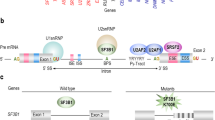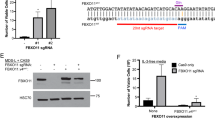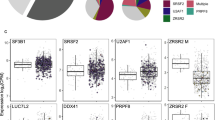Abstract
Spliceosome mutations represent a new generation of acquired genetic alterations that affect both myeloid and lymphoid malignancies. A substantial proportion of patients with myelodysplastic syndromes (MDSs) or chronic lymphocytic leukemia (CLL) harbor such mutations, which are often missense in type. Genotype–phenotype associations have been demonstrated for one of these mutations, SF3B1, with ring sideroblasts in MDS and 11q22 deletions in CLL. Spliceosome mutations might result in defective spliceosome assembly, deregulated global mRNA splicing, nuclear-cytoplasm export and altered expression of multiple genes. Such mutations are infrequent in other lymphomas, which instead display a separate group of novel mutations involving genes whose products are believed to affect histone acetylation and methylation and chromatin structure (for example, EZH2 and MLL2). On the other hand, some mutations (for example, NOTCH1) occur in both CLL and other immature and mature lymphoid malignancies. In the current review, we discuss potential mechanisms of cell transformation associated with spliceosome mutations, touch upon the increasing evidence regarding the clonal involvement of hematopoietic stem cells in some cases of otherwise mature lymphoid disorders and summarize recent information on recently described mutations in lymphomas.
This is a preview of subscription content, access via your institution
Access options
Subscribe to this journal
Receive 12 print issues and online access
$259.00 per year
only $21.58 per issue
Buy this article
- Purchase on Springer Link
- Instant access to full article PDF
Prices may be subject to local taxes which are calculated during checkout

Similar content being viewed by others
References
Yoshida K, Sanada M, Shiraishi Y, Nowak D, Nagata Y, Yamamoto R et al. Frequent pathway mutations of splicing machinery in myelodysplasia. Nature 2011; 478: 64–69.
Graubert TA, Shen D, Ding L, Okeyo-Owuor T, Lunn CL, Shao J et al. Recurrent mutations in the U2AF1 splicing factor in myelodysplastic syndromes. Nat Genet 2011; 44: 53–57.
Papaemmanuil E, Cazzola M, Boultwood J, Malcovati L, Vyas P, Bowen D et al. Somatic SF3B1 Mutation in Myelodysplasia with Ring Sideroblasts. N Engl J Med 2011; 365: 1384–1395.
Wang L, Lawrence MS, Wan Y, Stojanov P, Sougnez C, Stevenson K et al. SF3B1 and other novel cancer genes in chronic lymphocytic leukemia. N Engl J Med 2011; 365: 2497–2506.
Puente XS, Pinyol M, Quesada V, Conde L, Ordonez GR, Villamor N et al. Whole-genome sequencing identifies recurrent mutations in chronic lymphocytic leukaemia. Nature 2011; 475: 101–105.
Quesada V, Conde L, Villamor N, Ordonez GR, Jares P, Bassaganyas L et al. Exome sequencing identifies recurrent mutations of the splicing factor SF3B1 gene in chronic lymphocytic leukemia. Nat Genet 2011; 44: 47–52.
Fabbri G, Rasi S, Rossi D, Trifonov V, Khiabanian H, Ma J et al. Analysis of the chronic lymphocytic leukemia coding genome: role of NOTCH1 mutational activation. J Exp Med 2011; 208: 1389–1401.
Wahl MC, Will CL, Luhrmann R . The spliceosome: design principles of a dynamic RNP machine. Cell 2009; 136: 701–718.
Hallier M, Lerga A, Barnache S, Tavitian A, Moreau-Gachelin F . The transcription factor Spi-1/PU.1 interacts with the potential splicing factor TLS. J Biol Chem 1998; 273: 4838–4842.
Hiriart E, Gruffat H, Buisson M, Mikaelian I, Keppler S, Meresse P et al. Interaction of the Epstein-Barr virus mRNA export factor EB2 with human Spen proteins SHARP, OTT1, and a novel member of the family, OTT3, links Spen proteins with splicing regulation and mRNA export. J Biol Chem 2005; 280: 36935–36945.
Mercher T, Coniat MB, Monni R, Mauchauffe M, Nguyen Khac F, Gressin L et al. Involvement of a human gene related to the Drosophila spen gene in the recurrent t(1;22) translocation of acute megakaryocytic leukemia. Proc Natl Acad Sci USA 2001; 98: 5776–5779.
Lindtner S, Zolotukhin AS, Uranishi H, Bear J, Kulkarni V, Smulevitch S et al. RNA-binding motif protein 15 binds to the RNA transport element RTE and provides a direct link to the NXF1 export pathway. J Biol Chem 2006; 281: 36915–36928.
Ma Z, Morris SW, Valentine V, Li M, Herbrick JA, Cui X et al. Fusion of two novel genes, RBM15 and MKL1, in the t(1;22)(p13;q13) of acute megakaryoblastic leukemia. Nat Genet 2001; 28: 220–221.
Xu S, Powers MA . Nuclear pore proteins and cancer. Semin Cell Dev Biol 2009; 20: 620–630.
Gough SM, Slape CI, Aplan PD . NUP98 gene fusions and hematopoietic malignancies: common themes and new biologic insights. Blood 2011; 118: 6247–6257.
Ren Y, Seo HS, Blobel G, Hoelz A . Structural and functional analysis of the interaction between the nucleoporin Nup98 and the mRNA export factor Rae1. Proc Natl Acad Sci USA 2010; 107: 10406–10411.
Hutten S, Kehlenbach RH . Nup214 is required for CRM1-dependent nuclear protein export in vivo. Mol Cell Biol 2006; 26: 6772–6785.
Isono K, Mizutani-Koseki Y, Komori T, Schmidt-Zachmann MS, Koseki H . Mammalian polycomb-mediated repression of Hox genes requires the essential spliceosomal protein Sf3b1. Genes Dev 2005; 19: 536–541.
Kikushige Y, Ishikawa F, Miyamoto T, Shima T, Urata S, Yoshimoto G et al. Self-renewing hematopoietic stem cell is the primary target in pathogenesis of human chronic lymphocytic leukemia. Cancer Cell 2011; 20: 246–259.
Quivoron C, Couronne L, Della Valle V, Lopez CK, Plo I, Wagner-Ballon O et al. TET2 Inactivation results in pleiotropic hematopoietic abnormalities in mouse and is a recurrent event during human lymphomagenesis. Cancer Cell 2011; 20: 25–38.
Couronne L, Bastard C, Bernard OA . TET2 and DNMT3A Mutations in Human T-Cell Lymphoma. N Engl J Med 2012; 366: 95–96.
Damm F, Thol F, Kosmider O, Kade S, Loffeld P, Dreyfus F et al. SF3B1 mutations in myelodysplastic syndromes: clinical associations and prognostic implications. Leukemia 2011; e-pub ahead of print 8 November 2011.
Patnaik MM, Lasho TL, Hodnefield JM, Knudson RA, Ketterling RP, Garcia-Manero G et al. SF3B1 mutations are prevalent in myelodysplastic syndromes with ring sideroblasts but do not hold independent prognostic value. Blood 2011; 119: 569–572.
Visconte V, Makishima H, Jankowska A, Szpurka H, Traina F, Jerez A et al. SF3B1, a splicing factor is frequently mutated in refractory anemia with ring sideroblasts. Leukemia 2011; 26: 542–545.
Malcovati L, Papaemmanuil E, Bowen DT, Boultwood J, Della Porta MG, Pascutto C et al. Clinical significance of SF3B1 mutations in myelodysplastic syndromes and myelodysplastic/myeloproliferative neoplasms. Blood 2011; 118: 6239–6246.
Rossi D, Bruscaggin A, Spina V, Rasi S, Khiabanian H, Messina M et al. Mutations of the SF3B1 splicing factor in chronic lymphocytic leukemia: association with progression and fludarabine-refractoriness. Blood 2011; 118: 6904–6908.
Makishima H, Visconte V, Sakaguchi H, Jankowska AM, Abu Kar S, Jerez A et al. Mutations in the spliceosome machinery, a novel and ubiquitous pathway in leukemogenesis. Blood 2012; 119: 3203–3210.
Thol F, Kade S, Schlarmann C, Loffeld P, Morgan M, Krauter J et al. Frequency and prognostic impact of mutations in SRSF2, U2AF1, and ZRSR2 in patients with myelodysplastic syndromes. Blood 2012; 119: 3578–3584.
Damm F, Kosmider O, Gelsi-Boyer V, Renneville A, Carbuccia N, Hidalgo-Curtis C et al. Mutations affecting mRNA splicing define distinct clinical phenotypes and correlate with patient outcome in myelodysplastic syndromes. Blood 2012; 119: 3211–3218.
Zhang SJ, Rampal R, Manshouri T, Patel J, Mensah N, Kayserian A et al. Genetic analysis of patients with leukemic transformation of myeloproliferative neoplasms reveals recurrent SRSF2 mutations which are associated with adverse outcome. Blood 2012; e-pub ahead of print 19 March 2012.
Will CL, Luhrmann R . Spliceosome structure and function. Cold Spring Harb Perspect Biol 2011; 3, pii: a003707.
Christofk HR, Vander Heiden MG, Harris MH, Ramanathan A, Gerszten RE, Wei R et al. The M2 splice isoform of pyruvate kinase is important for cancer metabolism and tumour growth. Nature 2008; 452: 230–233.
Gabut M, Samavarchi-Tehrani P, Wang X, Slobodeniuc V, O'Hanlon D, Sung HK et al. An alternative splicing switch regulates embryonic stem cell pluripotency and reprogramming. Cell 2011; 147: 132–146.
Alexander RD, Innocente SA, Barrass JD, Beggs JD . Splicing-dependent RNA polymerase pausing in yeast. Mol Cell 2010; 40: 582–593.
Carrillo Oesterreich F, Bieberstein N, Neugebauer KM . Pause locally, splice globally. Trends Cell Biol 2011; 21: 328–335.
Luco RF, Misteli T. . More than a splicing code: integrating the role of RNA, chromatin and non-coding RNA in alternative splicing regulation. Curr Opin Genet Dev 2011; 21: 366–372.
Luco RF, Pan Q, Tominaga K, Blencowe BJ, Pereira-Smith OM, Misteli T . Regulation of alternative splicing by histone modifications. Science 2010; 327: 996–1000.
Martinez E, Palhan VB, Tjernberg A, Lymar ES, Gamper AM, Kundu TK et al. Human STAGA complex is a chromatin-acetylating transcription coactivator that interacts with pre-mRNA splicing and DNA damage-binding factors in vivo. Mol Cell Biol 2001; 21: 6782–6795.
Lemieux C, Marguerat S, Lafontaine J, Barbezier N, Bahler J, Bachand F . A Pre-mRNA degradation pathway that selectively targets intron-containing genes requires the nuclear poly(A)-binding protein. Mol Cell 2011; 44: 108–119.
Jenny A, Hauri HP, Keller W . Characterization of cleavage and polyadenylation specificity factor and cloning of its 100-kilodalton subunit. Mol Cell Biol 1994; 14: 8183–8190.
Montpetit B, Thomsen ND, Helmke KJ, Seeliger MA, Berger JM, Weis K . A conserved mechanism of DEAD-box ATPase activation by nucleoporins and InsP6 in mRNA export. Nature 2011; 472: 238–242.
Rosner A, Rinkevich B . The DDX3 subfamily of the DEAD box helicases: divergent roles as unveiled by studying different organisms and in vitro assays. Curr Med Chem 2007; 14: 2517–2525.
Hutten S, Kehlenbach RH . CRM1-mediated nuclear export: to the pore and beyond. Trends Cell Biol 2007; 17: 193–201.
Chapman MA, Lawrence MS, Keats JJ, Cibulskis K, Sougnez C, Schinzel AC et al. Initial genome sequencing and analysis of multiple myeloma. Nature 2011; 471: 467–472.
Schaeffer D, Tsanova B, Barbas A, Reis FP, Dastidar EG, Sanchez-Rotunno M et al. The exosome contains domains with specific endoribonuclease, exoribonuclease and cytoplasmic mRNA decay activities. Nat Struct Mol Biol 2009; 16: 56–62.
van Dijk EL, Chen CL, d'Aubenton-Carafa Y, Gourvennec S, Kwapisz M, Roche V et al. XUTs are a class of Xrn1-sensitive antisense regulatory non-coding RNA in yeast. Nature 2011; 475: 114–117.
Ding L, Ley TJ, Larson DE, Miller CA, Koboldt DC, Welch JS et al. Clonal evolution in relapsed acute myeloid leukaemia revealed by whole-genome sequencing. Nature 2012; 481: 506–510.
Drolet RE, Sanders JM, Kern JT . Leucine-rich repeat kinase 2 (LRRK2) cellular biology: a review of recent advances in identifying physiological substrates and cellular functions. J Neurogenet 2011; 25: 140–151.
Ebert BL . Molecular dissection of the 5q deletion in myelodysplastic syndrome. Semin Oncol 2011; 38: 621–626.
Yokoi A, Kotake Y, Takahashi K, Kadowaki T, Matsumoto Y, Minoshima Y et al. Biological validation that SF3b is a target of the antitumor macrolide pladienolide. FEBS J 2011; 278: 4870–4880.
Pasqualucci L, Trifonov V, Fabbri G, Ma J, Rossi D, Chiarenza A et al. Analysis of the coding genome of diffuse large B-cell lymphoma. Nat Genet 2011; 43: 830–837.
Morin RD, Mendez-Lago M, Mungall AJ, Goya R, Mungall KL, Corbett RD et al. Frequent mutation of histone-modifying genes in non-Hodgkin lymphoma. Nature 2011; 476: 298–303.
Morin RD, Johnson NA, Severson TM, Mungall AJ, An J, Goya R et al. Somatic mutations altering EZH2 (Tyr641) in follicular and diffuse large B-cell lymphomas of germinal-center origin. Nat Genet 2010; 42: 181–185.
Sneeringer CJ, Scott MP, Kuntz KW, Knutson SK, Pollock RM, Richon VM et al. Coordinated activities of wild-type plus mutant EZH2 drive tumor-associated hypertrimethylation of lysine 27 on histone H3 (H3K27) in human B-cell lymphomas. Proc Natl Acad Sci USA 2010; 107: 20980–20985.
Yap DB, Chu J, Berg T, Schapira M, Cheng SW, Moradian A et al. Somatic mutations at EZH2 Y641 act dominantly through a mechanism of selectively altered PRC2 catalytic activity, to increase H3K27 trimethylation. Blood 2011; 117: 2451–2459.
Pasqualucci L, Dominguez-Sola D, Chiarenza A, Fabbri G, Grunn A, Trifonov V et al. Inactivating mutations of acetyltransferase genes in B-cell lymphoma. Nature 2011; 471: 189–195.
Pasini D, Malatesta M, Jung HR, Walfridsson J, Willer A, Olsson L et al. Characterization of an antagonistic switch between histone H3 lysine 27 methylation and acetylation in the transcriptional regulation of Polycomb group target genes. Nucleic Acids Res 2010; 38: 4958–4969.
Rui L, Emre NC, Kruhlak MJ, Chung HJ, Steidl C, Slack G et al. Cooperative epigenetic modulation by cancer amplicon genes. Cancer Cell 2010; 18: 590–605.
Shaffer AL, Young RM, Staudt LM . Pathogenesis of human B-cell lymphomas. Ann Rev Immunol 2012; 30: 565–610.
Ferrando AA . The role of NOTCH1 signaling in T-ALL. Hematol Am Soc Hematol Educ Program 2009; 2009: 353–361.
Di Ianni M, Baldoni S, Rosati E, Ciurnelli R, Cavalli L, Martelli MF et al. A new genetic lesion in B-CLL: a NOTCH1 PEST domain mutation. Br J Haematol 2009; 146: 689–691.
Kridel R, Meissner B, Rogic S, Boyle M, Telenius A, Woolcock B et al. Whole transcriptome sequencing reveals recurrent NOTCH1 mutations in mantle cell lymphoma. Blood 2012; 119: 1963–1971.
Lobry C, Oh P, Aifantis I . Oncogenic and tumor suppressor functions of Notch in cancer: it's NOTCH what you think. J Exp Med 2011; 208: 1931–1935.
Thompson BJ, Jankovic V, Gao J, Buonamici S, Vest A, Lee JM et al. Control of hematopoietic stem cell quiescence by the E3 ubiquitin ligase Fbw7. J Exp Med 2008; 205: 1395–1408.
Rossi D, Rasi S, Fabbri G, Spina V, Fangazio M, Forconi F et al. Mutations of NOTCH1 are an independent predictor of survival in chronic lymphocytic leukemia. Blood 2012; 119: 521–529.
Sportoletti P, Baldoni S, Cavalli L, Del Papa B, Bonifacio E, Ciurnelli R et al. NOTCH1 PEST domain mutation is an adverse prognostic factor in B-CLL. Br J Haematol 2010; 151: 404–406.
Balatti V, Bottoni A, Palamarchuk A, Alder H, Rassenti LZ, Kipps TJ et al. NOTCH1 mutations in CLL associated with trisomy 12. Blood 2012; 119: 329–331.
Del Giudice I, Rossi D, Chiaretti S, Marinelli M, Tavolaro S, Gabrielli S et al. NOTCH1 mutations in +12 chronic lymphocytic leukemia (CLL) confer an unfavorable prognosis, induce a distinctive transcriptional profiling and refine the intermediate prognosis of +12 CLL. Haematologica 2011; 97: 437–441.
Ngo VN, Young RM, Schmitz R, Jhavar S, Xiao W, Lim KH et al. Oncogenically active MYD88 mutations in human lymphoma. Nature 2011; 470: 115–119.
Rui L, Schmitz R, Ceribelli M, Staudt LM . Malignant pirates of the immune system. Nat Immunol 2011; 12: 933–940.
Lasho TL, Finke CM, Hanson CA, Jimma T, Knudson RA, Ketterling RP et al. SF3B1 mutations in primary myelofibrosis: clinical, histopathology and genetic correlates among 155 patients. Leukemia 2011; e-pub ahead of print 8 November 2011; doi:10.1038/leu.2011.320.
Acknowledgements
Work in the authors’ laboratories was supported by the INSERM, Direction de la recherche clinique AP-HP (PHRC MDS-04), INCa, association Laurette Fugain and labellisation from Ligue Nationale Contre le Cancer. Frederik Damm is supported by a grant from the Deutsche Krebshilfe. We want to thank William Vainchenker, Daniel Birnbaum and Christian Bastard for their helpful discussion.
Author information
Authors and Affiliations
Corresponding author
Rights and permissions
About this article
Cite this article
Damm, F., Nguyen-Khac, F., Fontenay, M. et al. Spliceosome and other novel mutations in chronic lymphocytic leukemia and myeloid malignancies. Leukemia 26, 2027–2031 (2012). https://doi.org/10.1038/leu.2012.86
Received:
Revised:
Accepted:
Published:
Issue Date:
DOI: https://doi.org/10.1038/leu.2012.86
Keywords
This article is cited by
-
EGR2 mutations define a new clinically aggressive subgroup of chronic lymphocytic leukemia
Leukemia (2017)
-
Frequent somatic mutations in components of the RNA processing machinery in chronic lymphocytic leukemia
Leukemia (2013)
-
The spliceosome as a target of novel antitumour drugs
Nature Reviews Drug Discovery (2012)
-
Splicing factor mutations in myelodysplasia
International Journal of Hematology (2012)



